Colgate-Palmolive Cost Management, ABC & CSR Analysis, Spring 2018
VerifiedAdded on 2023/06/09
|17
|4723
|275
Report
AI Summary
This report examines Colgate-Palmolive's cost management and analysis, focusing on its oral care product category. It includes a value chain analysis, design of an activity-based costing (ABC) system, and an evaluation of corporate social responsibility (CSR) and sustainability reporting. The report identifies the company's business processes, including inbound logistics, operations, outbound logistics, marketing, sales, and services. The ABC system design outlines costly activities, cost drivers, and cost pools for toothpaste and breath-refreshing gel production. Finally, the report assesses Colgate-Palmolive's social and environmental performance, highlighting its strengths and potential future challenges. Desklib provides access to similar reports and study resources for students.
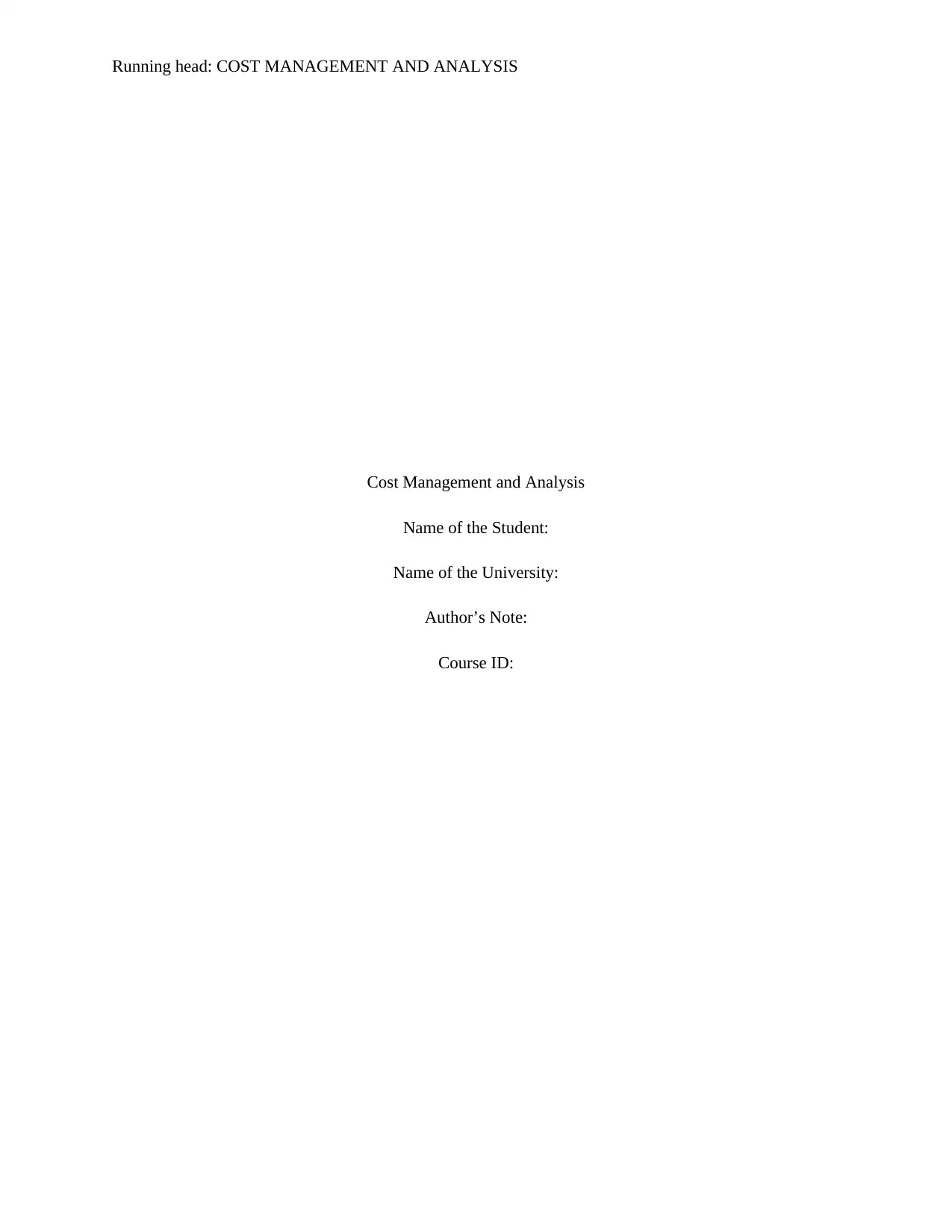
Running head: COST MANAGEMENT AND ANALYSIS
Cost Management and Analysis
Name of the Student:
Name of the University:
Author’s Note:
Course ID:
Cost Management and Analysis
Name of the Student:
Name of the University:
Author’s Note:
Course ID:
Paraphrase This Document
Need a fresh take? Get an instant paraphrase of this document with our AI Paraphraser
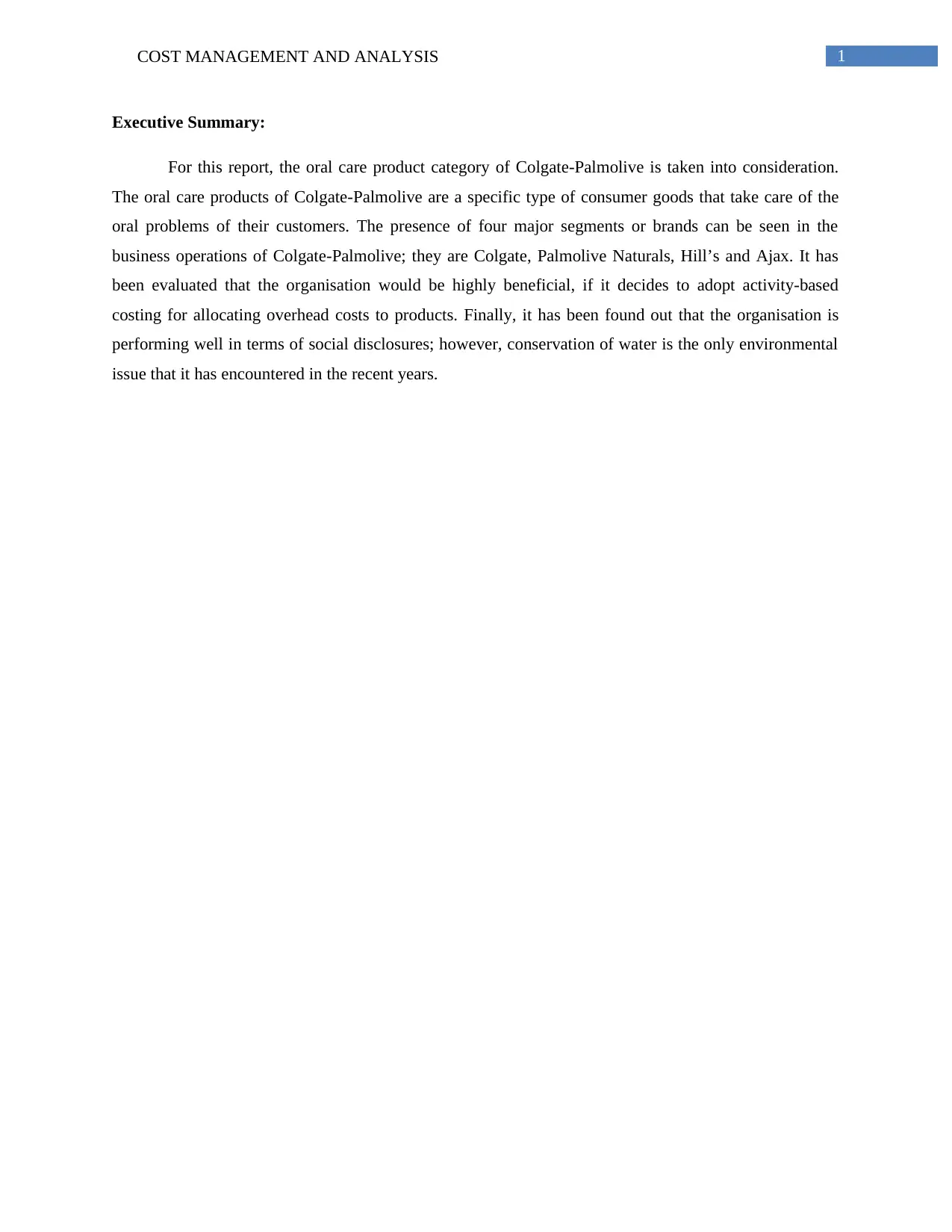
1COST MANAGEMENT AND ANALYSIS
Executive Summary:
For this report, the oral care product category of Colgate-Palmolive is taken into consideration.
The oral care products of Colgate-Palmolive are a specific type of consumer goods that take care of the
oral problems of their customers. The presence of four major segments or brands can be seen in the
business operations of Colgate-Palmolive; they are Colgate, Palmolive Naturals, Hill’s and Ajax. It has
been evaluated that the organisation would be highly beneficial, if it decides to adopt activity-based
costing for allocating overhead costs to products. Finally, it has been found out that the organisation is
performing well in terms of social disclosures; however, conservation of water is the only environmental
issue that it has encountered in the recent years.
Executive Summary:
For this report, the oral care product category of Colgate-Palmolive is taken into consideration.
The oral care products of Colgate-Palmolive are a specific type of consumer goods that take care of the
oral problems of their customers. The presence of four major segments or brands can be seen in the
business operations of Colgate-Palmolive; they are Colgate, Palmolive Naturals, Hill’s and Ajax. It has
been evaluated that the organisation would be highly beneficial, if it decides to adopt activity-based
costing for allocating overhead costs to products. Finally, it has been found out that the organisation is
performing well in terms of social disclosures; however, conservation of water is the only environmental
issue that it has encountered in the recent years.
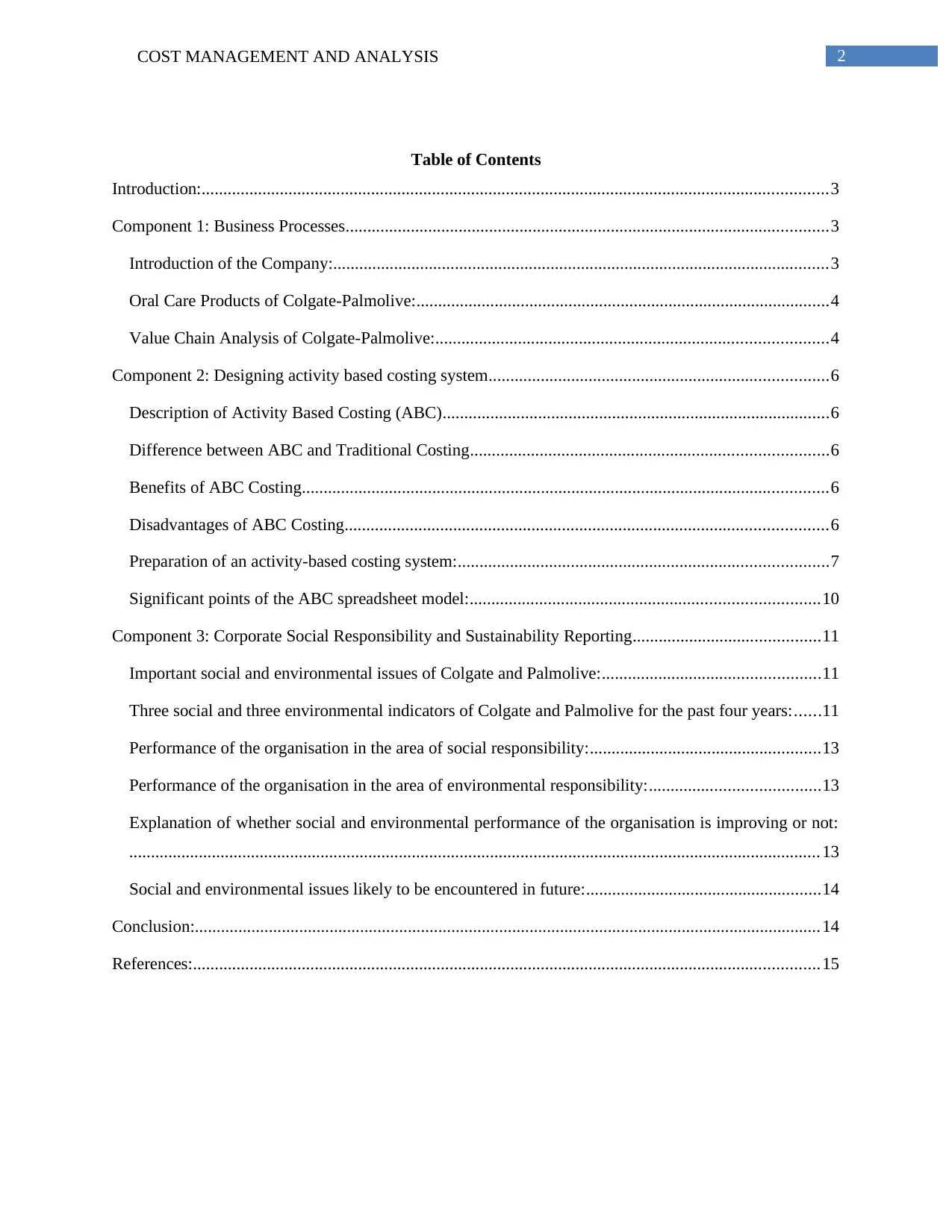
2COST MANAGEMENT AND ANALYSIS
Table of Contents
Introduction:................................................................................................................................................3
Component 1: Business Processes...............................................................................................................3
Introduction of the Company:..................................................................................................................3
Oral Care Products of Colgate-Palmolive:...............................................................................................4
Value Chain Analysis of Colgate-Palmolive:..........................................................................................4
Component 2: Designing activity based costing system..............................................................................6
Description of Activity Based Costing (ABC).........................................................................................6
Difference between ABC and Traditional Costing..................................................................................6
Benefits of ABC Costing.........................................................................................................................6
Disadvantages of ABC Costing...............................................................................................................6
Preparation of an activity-based costing system:.....................................................................................7
Significant points of the ABC spreadsheet model:................................................................................10
Component 3: Corporate Social Responsibility and Sustainability Reporting...........................................11
Important social and environmental issues of Colgate and Palmolive:..................................................11
Three social and three environmental indicators of Colgate and Palmolive for the past four years:......11
Performance of the organisation in the area of social responsibility:.....................................................13
Performance of the organisation in the area of environmental responsibility:.......................................13
Explanation of whether social and environmental performance of the organisation is improving or not:
...............................................................................................................................................................13
Social and environmental issues likely to be encountered in future:......................................................14
Conclusion:................................................................................................................................................14
References:................................................................................................................................................15
Table of Contents
Introduction:................................................................................................................................................3
Component 1: Business Processes...............................................................................................................3
Introduction of the Company:..................................................................................................................3
Oral Care Products of Colgate-Palmolive:...............................................................................................4
Value Chain Analysis of Colgate-Palmolive:..........................................................................................4
Component 2: Designing activity based costing system..............................................................................6
Description of Activity Based Costing (ABC).........................................................................................6
Difference between ABC and Traditional Costing..................................................................................6
Benefits of ABC Costing.........................................................................................................................6
Disadvantages of ABC Costing...............................................................................................................6
Preparation of an activity-based costing system:.....................................................................................7
Significant points of the ABC spreadsheet model:................................................................................10
Component 3: Corporate Social Responsibility and Sustainability Reporting...........................................11
Important social and environmental issues of Colgate and Palmolive:..................................................11
Three social and three environmental indicators of Colgate and Palmolive for the past four years:......11
Performance of the organisation in the area of social responsibility:.....................................................13
Performance of the organisation in the area of environmental responsibility:.......................................13
Explanation of whether social and environmental performance of the organisation is improving or not:
...............................................................................................................................................................13
Social and environmental issues likely to be encountered in future:......................................................14
Conclusion:................................................................................................................................................14
References:................................................................................................................................................15
⊘ This is a preview!⊘
Do you want full access?
Subscribe today to unlock all pages.

Trusted by 1+ million students worldwide
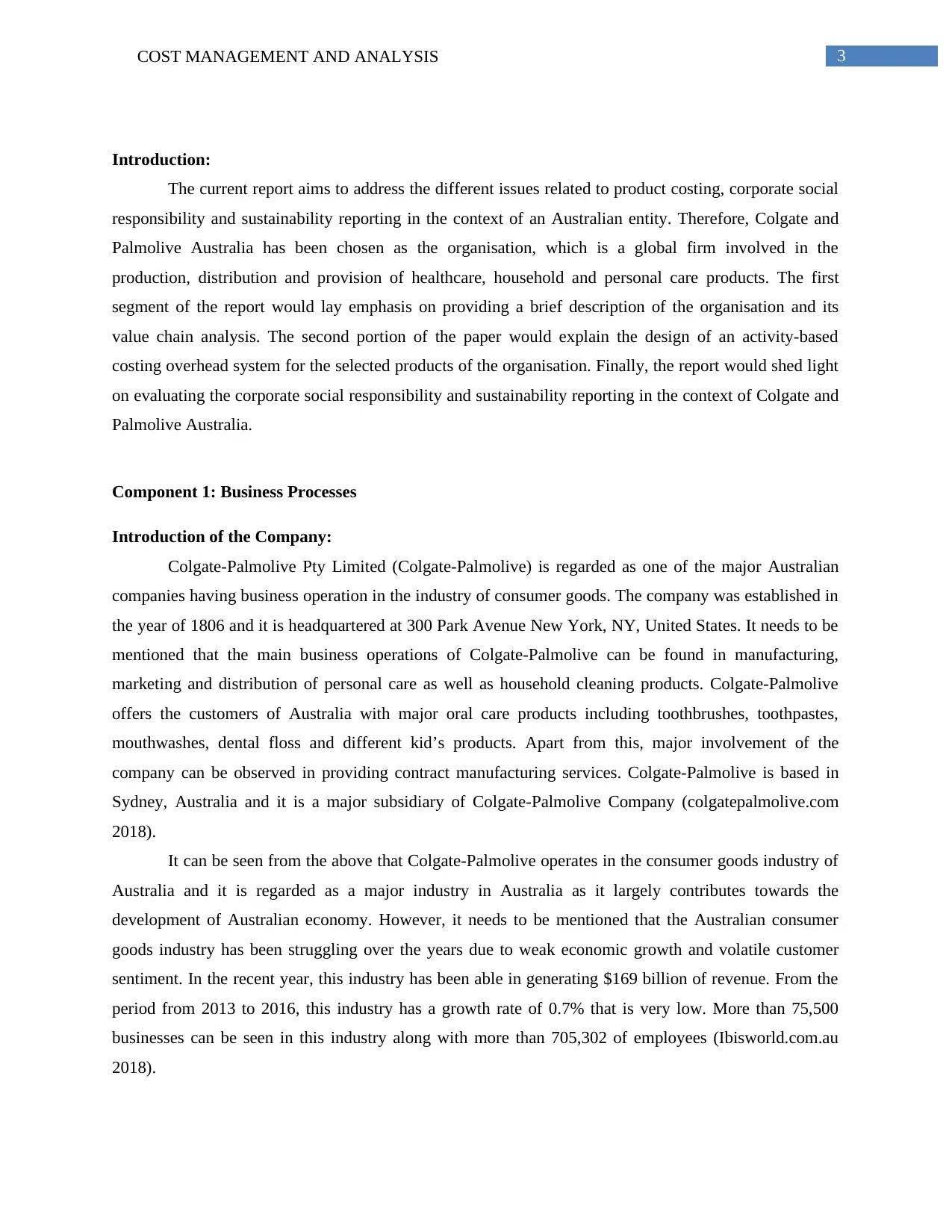
3COST MANAGEMENT AND ANALYSIS
Introduction:
The current report aims to address the different issues related to product costing, corporate social
responsibility and sustainability reporting in the context of an Australian entity. Therefore, Colgate and
Palmolive Australia has been chosen as the organisation, which is a global firm involved in the
production, distribution and provision of healthcare, household and personal care products. The first
segment of the report would lay emphasis on providing a brief description of the organisation and its
value chain analysis. The second portion of the paper would explain the design of an activity-based
costing overhead system for the selected products of the organisation. Finally, the report would shed light
on evaluating the corporate social responsibility and sustainability reporting in the context of Colgate and
Palmolive Australia.
Component 1: Business Processes
Introduction of the Company:
Colgate-Palmolive Pty Limited (Colgate-Palmolive) is regarded as one of the major Australian
companies having business operation in the industry of consumer goods. The company was established in
the year of 1806 and it is headquartered at 300 Park Avenue New York, NY, United States. It needs to be
mentioned that the main business operations of Colgate-Palmolive can be found in manufacturing,
marketing and distribution of personal care as well as household cleaning products. Colgate-Palmolive
offers the customers of Australia with major oral care products including toothbrushes, toothpastes,
mouthwashes, dental floss and different kid’s products. Apart from this, major involvement of the
company can be observed in providing contract manufacturing services. Colgate-Palmolive is based in
Sydney, Australia and it is a major subsidiary of Colgate-Palmolive Company (colgatepalmolive.com
2018).
It can be seen from the above that Colgate-Palmolive operates in the consumer goods industry of
Australia and it is regarded as a major industry in Australia as it largely contributes towards the
development of Australian economy. However, it needs to be mentioned that the Australian consumer
goods industry has been struggling over the years due to weak economic growth and volatile customer
sentiment. In the recent year, this industry has been able in generating $169 billion of revenue. From the
period from 2013 to 2016, this industry has a growth rate of 0.7% that is very low. More than 75,500
businesses can be seen in this industry along with more than 705,302 of employees (Ibisworld.com.au
2018).
Introduction:
The current report aims to address the different issues related to product costing, corporate social
responsibility and sustainability reporting in the context of an Australian entity. Therefore, Colgate and
Palmolive Australia has been chosen as the organisation, which is a global firm involved in the
production, distribution and provision of healthcare, household and personal care products. The first
segment of the report would lay emphasis on providing a brief description of the organisation and its
value chain analysis. The second portion of the paper would explain the design of an activity-based
costing overhead system for the selected products of the organisation. Finally, the report would shed light
on evaluating the corporate social responsibility and sustainability reporting in the context of Colgate and
Palmolive Australia.
Component 1: Business Processes
Introduction of the Company:
Colgate-Palmolive Pty Limited (Colgate-Palmolive) is regarded as one of the major Australian
companies having business operation in the industry of consumer goods. The company was established in
the year of 1806 and it is headquartered at 300 Park Avenue New York, NY, United States. It needs to be
mentioned that the main business operations of Colgate-Palmolive can be found in manufacturing,
marketing and distribution of personal care as well as household cleaning products. Colgate-Palmolive
offers the customers of Australia with major oral care products including toothbrushes, toothpastes,
mouthwashes, dental floss and different kid’s products. Apart from this, major involvement of the
company can be observed in providing contract manufacturing services. Colgate-Palmolive is based in
Sydney, Australia and it is a major subsidiary of Colgate-Palmolive Company (colgatepalmolive.com
2018).
It can be seen from the above that Colgate-Palmolive operates in the consumer goods industry of
Australia and it is regarded as a major industry in Australia as it largely contributes towards the
development of Australian economy. However, it needs to be mentioned that the Australian consumer
goods industry has been struggling over the years due to weak economic growth and volatile customer
sentiment. In the recent year, this industry has been able in generating $169 billion of revenue. From the
period from 2013 to 2016, this industry has a growth rate of 0.7% that is very low. More than 75,500
businesses can be seen in this industry along with more than 705,302 of employees (Ibisworld.com.au
2018).
Paraphrase This Document
Need a fresh take? Get an instant paraphrase of this document with our AI Paraphraser
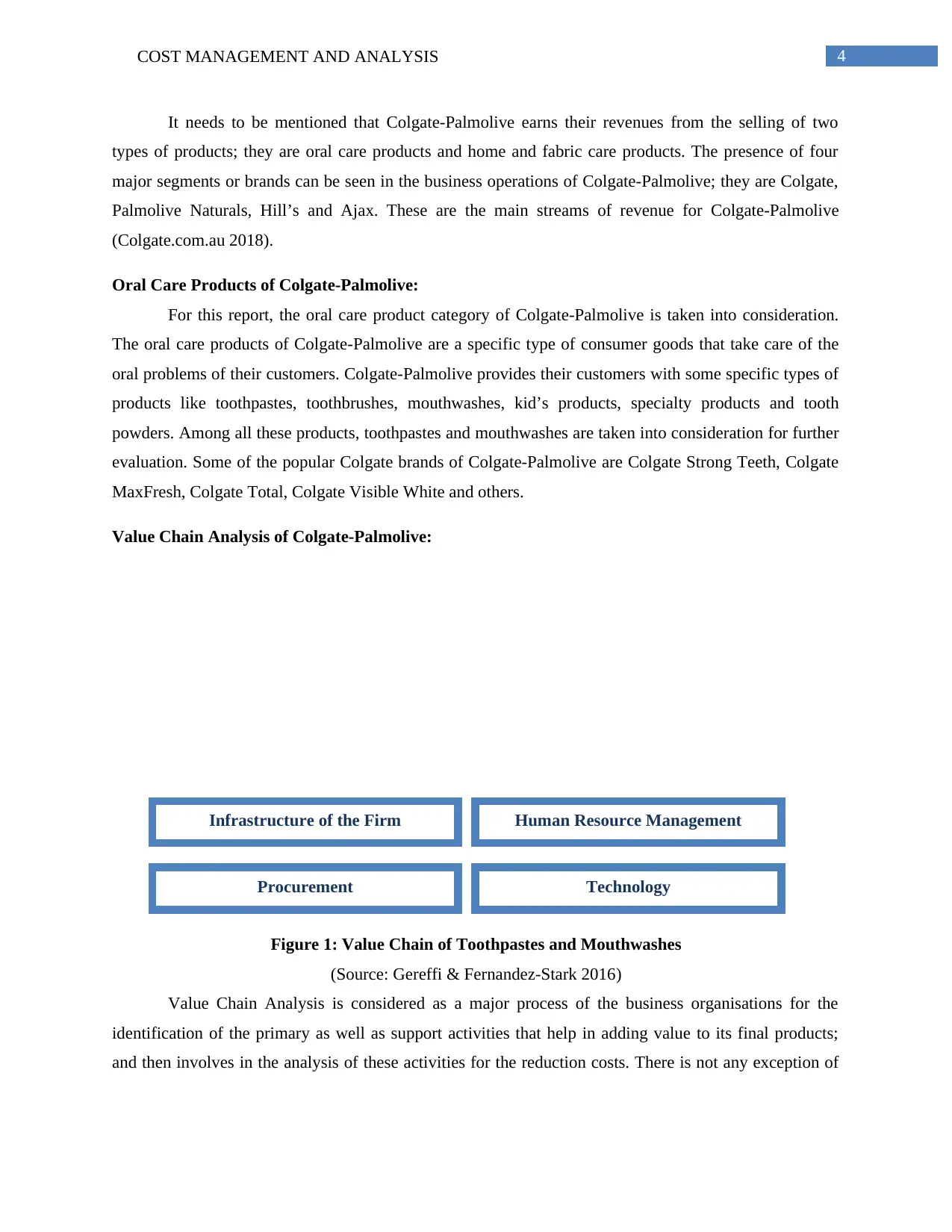
4COST MANAGEMENT AND ANALYSIS
It needs to be mentioned that Colgate-Palmolive earns their revenues from the selling of two
types of products; they are oral care products and home and fabric care products. The presence of four
major segments or brands can be seen in the business operations of Colgate-Palmolive; they are Colgate,
Palmolive Naturals, Hill’s and Ajax. These are the main streams of revenue for Colgate-Palmolive
(Colgate.com.au 2018).
Oral Care Products of Colgate-Palmolive:
For this report, the oral care product category of Colgate-Palmolive is taken into consideration.
The oral care products of Colgate-Palmolive are a specific type of consumer goods that take care of the
oral problems of their customers. Colgate-Palmolive provides their customers with some specific types of
products like toothpastes, toothbrushes, mouthwashes, kid’s products, specialty products and tooth
powders. Among all these products, toothpastes and mouthwashes are taken into consideration for further
evaluation. Some of the popular Colgate brands of Colgate-Palmolive are Colgate Strong Teeth, Colgate
MaxFresh, Colgate Total, Colgate Visible White and others.
Value Chain Analysis of Colgate-Palmolive:
Figure 1: Value Chain of Toothpastes and Mouthwashes
(Source: Gereffi & Fernandez-Stark 2016)
Value Chain Analysis is considered as a major process of the business organisations for the
identification of the primary as well as support activities that help in adding value to its final products;
and then involves in the analysis of these activities for the reduction costs. There is not any exception of
InboundLogisticsOperationsOutboundLogisticsMarketing&SalesServicsInfrastructure of the Firm Human Resource Management
TechnologyProcurement
It needs to be mentioned that Colgate-Palmolive earns their revenues from the selling of two
types of products; they are oral care products and home and fabric care products. The presence of four
major segments or brands can be seen in the business operations of Colgate-Palmolive; they are Colgate,
Palmolive Naturals, Hill’s and Ajax. These are the main streams of revenue for Colgate-Palmolive
(Colgate.com.au 2018).
Oral Care Products of Colgate-Palmolive:
For this report, the oral care product category of Colgate-Palmolive is taken into consideration.
The oral care products of Colgate-Palmolive are a specific type of consumer goods that take care of the
oral problems of their customers. Colgate-Palmolive provides their customers with some specific types of
products like toothpastes, toothbrushes, mouthwashes, kid’s products, specialty products and tooth
powders. Among all these products, toothpastes and mouthwashes are taken into consideration for further
evaluation. Some of the popular Colgate brands of Colgate-Palmolive are Colgate Strong Teeth, Colgate
MaxFresh, Colgate Total, Colgate Visible White and others.
Value Chain Analysis of Colgate-Palmolive:
Figure 1: Value Chain of Toothpastes and Mouthwashes
(Source: Gereffi & Fernandez-Stark 2016)
Value Chain Analysis is considered as a major process of the business organisations for the
identification of the primary as well as support activities that help in adding value to its final products;
and then involves in the analysis of these activities for the reduction costs. There is not any exception of
InboundLogisticsOperationsOutboundLogisticsMarketing&SalesServicsInfrastructure of the Firm Human Resource Management
TechnologyProcurement
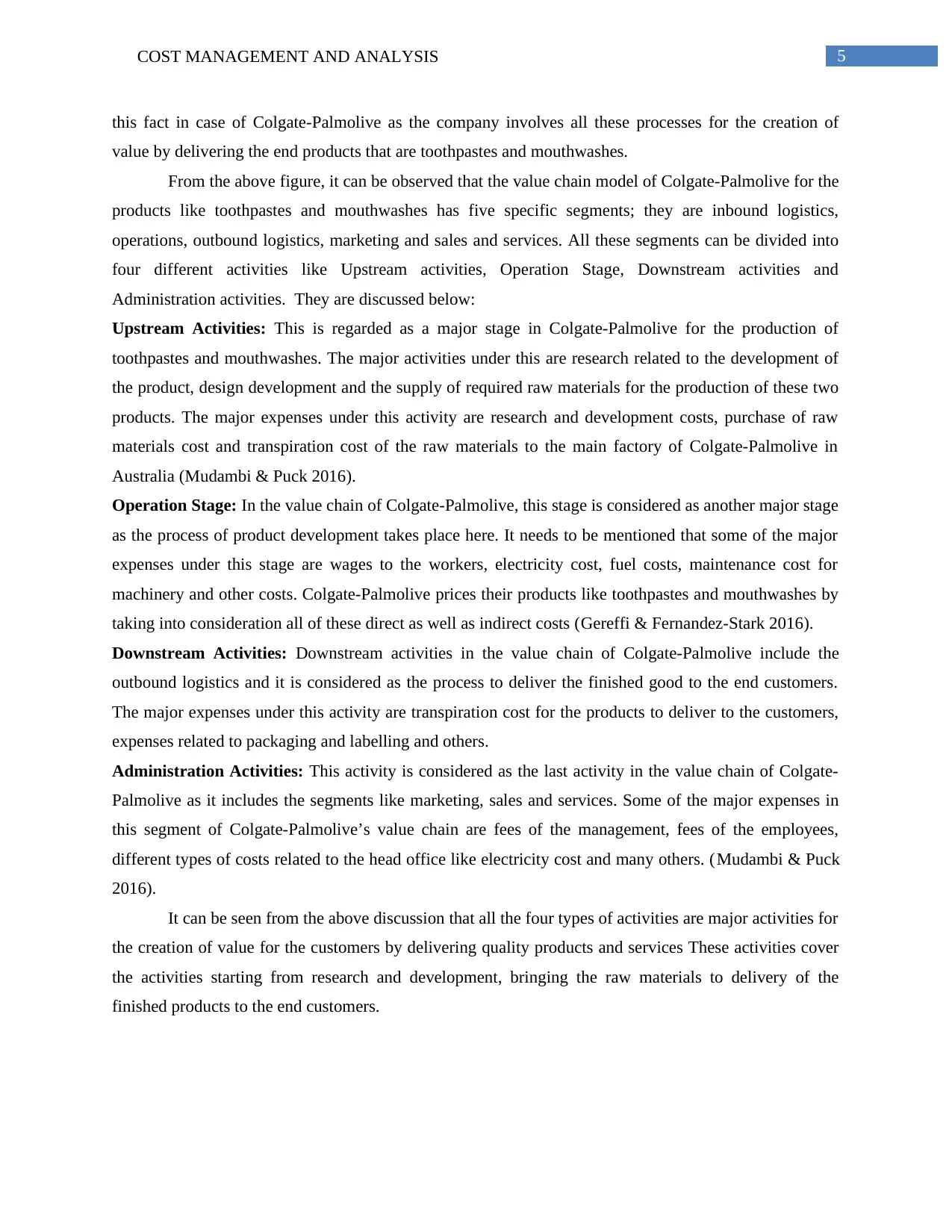
5COST MANAGEMENT AND ANALYSIS
this fact in case of Colgate-Palmolive as the company involves all these processes for the creation of
value by delivering the end products that are toothpastes and mouthwashes.
From the above figure, it can be observed that the value chain model of Colgate-Palmolive for the
products like toothpastes and mouthwashes has five specific segments; they are inbound logistics,
operations, outbound logistics, marketing and sales and services. All these segments can be divided into
four different activities like Upstream activities, Operation Stage, Downstream activities and
Administration activities. They are discussed below:
Upstream Activities: This is regarded as a major stage in Colgate-Palmolive for the production of
toothpastes and mouthwashes. The major activities under this are research related to the development of
the product, design development and the supply of required raw materials for the production of these two
products. The major expenses under this activity are research and development costs, purchase of raw
materials cost and transpiration cost of the raw materials to the main factory of Colgate-Palmolive in
Australia (Mudambi & Puck 2016).
Operation Stage: In the value chain of Colgate-Palmolive, this stage is considered as another major stage
as the process of product development takes place here. It needs to be mentioned that some of the major
expenses under this stage are wages to the workers, electricity cost, fuel costs, maintenance cost for
machinery and other costs. Colgate-Palmolive prices their products like toothpastes and mouthwashes by
taking into consideration all of these direct as well as indirect costs (Gereffi & Fernandez-Stark 2016).
Downstream Activities: Downstream activities in the value chain of Colgate-Palmolive include the
outbound logistics and it is considered as the process to deliver the finished good to the end customers.
The major expenses under this activity are transpiration cost for the products to deliver to the customers,
expenses related to packaging and labelling and others.
Administration Activities: This activity is considered as the last activity in the value chain of Colgate-
Palmolive as it includes the segments like marketing, sales and services. Some of the major expenses in
this segment of Colgate-Palmolive’s value chain are fees of the management, fees of the employees,
different types of costs related to the head office like electricity cost and many others. (Mudambi & Puck
2016).
It can be seen from the above discussion that all the four types of activities are major activities for
the creation of value for the customers by delivering quality products and services These activities cover
the activities starting from research and development, bringing the raw materials to delivery of the
finished products to the end customers.
this fact in case of Colgate-Palmolive as the company involves all these processes for the creation of
value by delivering the end products that are toothpastes and mouthwashes.
From the above figure, it can be observed that the value chain model of Colgate-Palmolive for the
products like toothpastes and mouthwashes has five specific segments; they are inbound logistics,
operations, outbound logistics, marketing and sales and services. All these segments can be divided into
four different activities like Upstream activities, Operation Stage, Downstream activities and
Administration activities. They are discussed below:
Upstream Activities: This is regarded as a major stage in Colgate-Palmolive for the production of
toothpastes and mouthwashes. The major activities under this are research related to the development of
the product, design development and the supply of required raw materials for the production of these two
products. The major expenses under this activity are research and development costs, purchase of raw
materials cost and transpiration cost of the raw materials to the main factory of Colgate-Palmolive in
Australia (Mudambi & Puck 2016).
Operation Stage: In the value chain of Colgate-Palmolive, this stage is considered as another major stage
as the process of product development takes place here. It needs to be mentioned that some of the major
expenses under this stage are wages to the workers, electricity cost, fuel costs, maintenance cost for
machinery and other costs. Colgate-Palmolive prices their products like toothpastes and mouthwashes by
taking into consideration all of these direct as well as indirect costs (Gereffi & Fernandez-Stark 2016).
Downstream Activities: Downstream activities in the value chain of Colgate-Palmolive include the
outbound logistics and it is considered as the process to deliver the finished good to the end customers.
The major expenses under this activity are transpiration cost for the products to deliver to the customers,
expenses related to packaging and labelling and others.
Administration Activities: This activity is considered as the last activity in the value chain of Colgate-
Palmolive as it includes the segments like marketing, sales and services. Some of the major expenses in
this segment of Colgate-Palmolive’s value chain are fees of the management, fees of the employees,
different types of costs related to the head office like electricity cost and many others. (Mudambi & Puck
2016).
It can be seen from the above discussion that all the four types of activities are major activities for
the creation of value for the customers by delivering quality products and services These activities cover
the activities starting from research and development, bringing the raw materials to delivery of the
finished products to the end customers.
⊘ This is a preview!⊘
Do you want full access?
Subscribe today to unlock all pages.

Trusted by 1+ million students worldwide
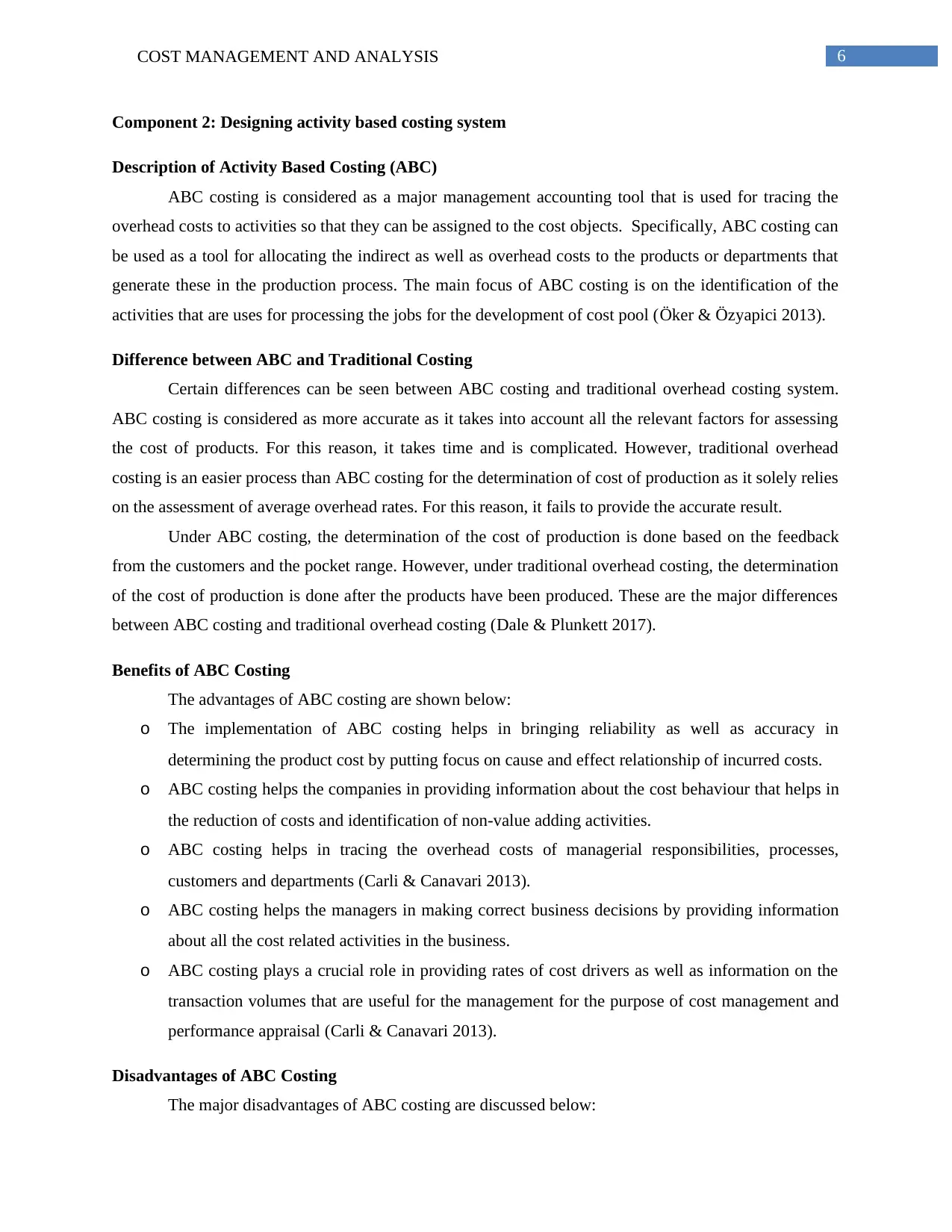
6COST MANAGEMENT AND ANALYSIS
Component 2: Designing activity based costing system
Description of Activity Based Costing (ABC)
ABC costing is considered as a major management accounting tool that is used for tracing the
overhead costs to activities so that they can be assigned to the cost objects. Specifically, ABC costing can
be used as a tool for allocating the indirect as well as overhead costs to the products or departments that
generate these in the production process. The main focus of ABC costing is on the identification of the
activities that are uses for processing the jobs for the development of cost pool (Öker & Özyapici 2013).
Difference between ABC and Traditional Costing
Certain differences can be seen between ABC costing and traditional overhead costing system.
ABC costing is considered as more accurate as it takes into account all the relevant factors for assessing
the cost of products. For this reason, it takes time and is complicated. However, traditional overhead
costing is an easier process than ABC costing for the determination of cost of production as it solely relies
on the assessment of average overhead rates. For this reason, it fails to provide the accurate result.
Under ABC costing, the determination of the cost of production is done based on the feedback
from the customers and the pocket range. However, under traditional overhead costing, the determination
of the cost of production is done after the products have been produced. These are the major differences
between ABC costing and traditional overhead costing (Dale & Plunkett 2017).
Benefits of ABC Costing
The advantages of ABC costing are shown below:
o The implementation of ABC costing helps in bringing reliability as well as accuracy in
determining the product cost by putting focus on cause and effect relationship of incurred costs.
o ABC costing helps the companies in providing information about the cost behaviour that helps in
the reduction of costs and identification of non-value adding activities.
o ABC costing helps in tracing the overhead costs of managerial responsibilities, processes,
customers and departments (Carli & Canavari 2013).
o ABC costing helps the managers in making correct business decisions by providing information
about all the cost related activities in the business.
o ABC costing plays a crucial role in providing rates of cost drivers as well as information on the
transaction volumes that are useful for the management for the purpose of cost management and
performance appraisal (Carli & Canavari 2013).
Disadvantages of ABC Costing
The major disadvantages of ABC costing are discussed below:
Component 2: Designing activity based costing system
Description of Activity Based Costing (ABC)
ABC costing is considered as a major management accounting tool that is used for tracing the
overhead costs to activities so that they can be assigned to the cost objects. Specifically, ABC costing can
be used as a tool for allocating the indirect as well as overhead costs to the products or departments that
generate these in the production process. The main focus of ABC costing is on the identification of the
activities that are uses for processing the jobs for the development of cost pool (Öker & Özyapici 2013).
Difference between ABC and Traditional Costing
Certain differences can be seen between ABC costing and traditional overhead costing system.
ABC costing is considered as more accurate as it takes into account all the relevant factors for assessing
the cost of products. For this reason, it takes time and is complicated. However, traditional overhead
costing is an easier process than ABC costing for the determination of cost of production as it solely relies
on the assessment of average overhead rates. For this reason, it fails to provide the accurate result.
Under ABC costing, the determination of the cost of production is done based on the feedback
from the customers and the pocket range. However, under traditional overhead costing, the determination
of the cost of production is done after the products have been produced. These are the major differences
between ABC costing and traditional overhead costing (Dale & Plunkett 2017).
Benefits of ABC Costing
The advantages of ABC costing are shown below:
o The implementation of ABC costing helps in bringing reliability as well as accuracy in
determining the product cost by putting focus on cause and effect relationship of incurred costs.
o ABC costing helps the companies in providing information about the cost behaviour that helps in
the reduction of costs and identification of non-value adding activities.
o ABC costing helps in tracing the overhead costs of managerial responsibilities, processes,
customers and departments (Carli & Canavari 2013).
o ABC costing helps the managers in making correct business decisions by providing information
about all the cost related activities in the business.
o ABC costing plays a crucial role in providing rates of cost drivers as well as information on the
transaction volumes that are useful for the management for the purpose of cost management and
performance appraisal (Carli & Canavari 2013).
Disadvantages of ABC Costing
The major disadvantages of ABC costing are discussed below:
Paraphrase This Document
Need a fresh take? Get an instant paraphrase of this document with our AI Paraphraser
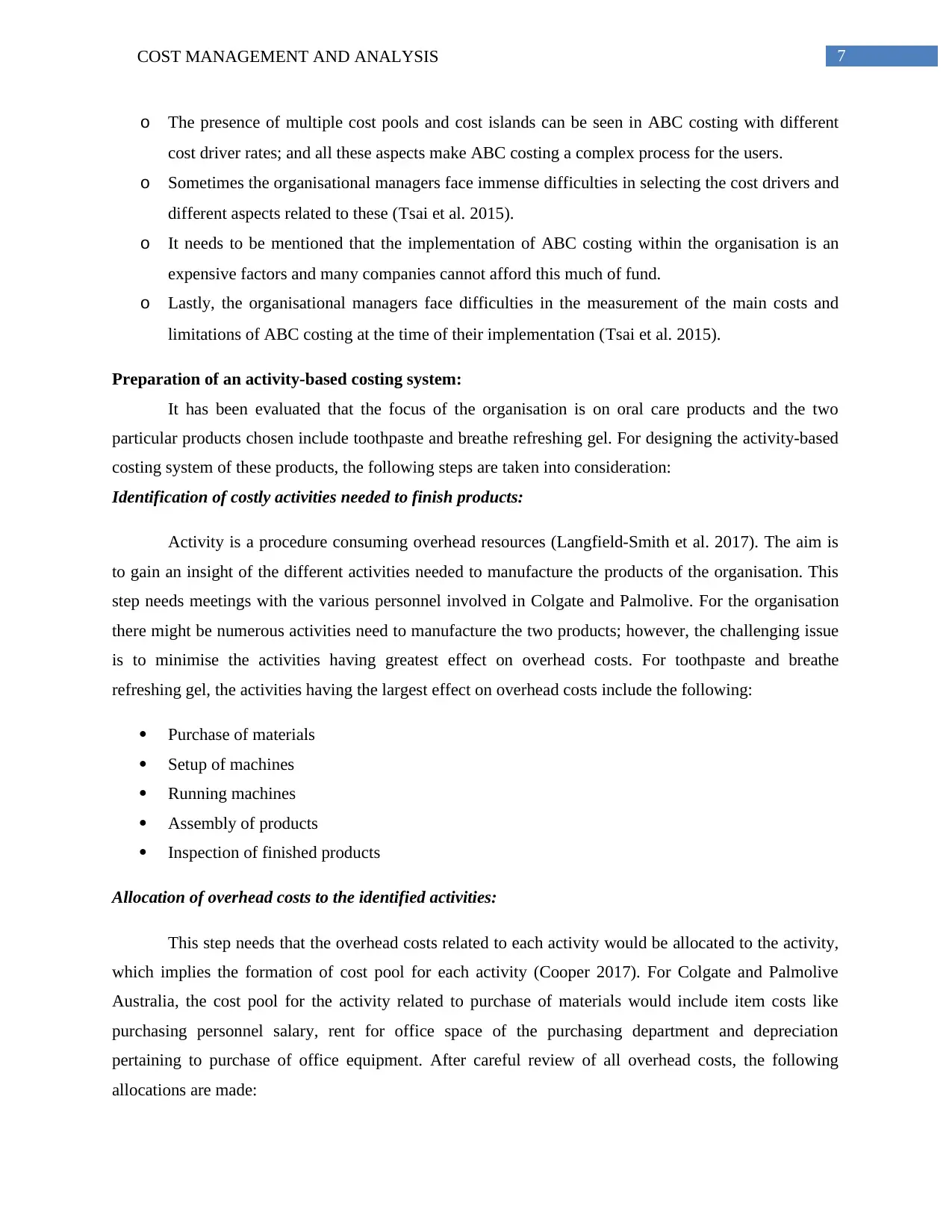
7COST MANAGEMENT AND ANALYSIS
o The presence of multiple cost pools and cost islands can be seen in ABC costing with different
cost driver rates; and all these aspects make ABC costing a complex process for the users.
o Sometimes the organisational managers face immense difficulties in selecting the cost drivers and
different aspects related to these (Tsai et al. 2015).
o It needs to be mentioned that the implementation of ABC costing within the organisation is an
expensive factors and many companies cannot afford this much of fund.
o Lastly, the organisational managers face difficulties in the measurement of the main costs and
limitations of ABC costing at the time of their implementation (Tsai et al. 2015).
Preparation of an activity-based costing system:
It has been evaluated that the focus of the organisation is on oral care products and the two
particular products chosen include toothpaste and breathe refreshing gel. For designing the activity-based
costing system of these products, the following steps are taken into consideration:
Identification of costly activities needed to finish products:
Activity is a procedure consuming overhead resources (Langfield-Smith et al. 2017). The aim is
to gain an insight of the different activities needed to manufacture the products of the organisation. This
step needs meetings with the various personnel involved in Colgate and Palmolive. For the organisation
there might be numerous activities need to manufacture the two products; however, the challenging issue
is to minimise the activities having greatest effect on overhead costs. For toothpaste and breathe
refreshing gel, the activities having the largest effect on overhead costs include the following:
Purchase of materials
Setup of machines
Running machines
Assembly of products
Inspection of finished products
Allocation of overhead costs to the identified activities:
This step needs that the overhead costs related to each activity would be allocated to the activity,
which implies the formation of cost pool for each activity (Cooper 2017). For Colgate and Palmolive
Australia, the cost pool for the activity related to purchase of materials would include item costs like
purchasing personnel salary, rent for office space of the purchasing department and depreciation
pertaining to purchase of office equipment. After careful review of all overhead costs, the following
allocations are made:
o The presence of multiple cost pools and cost islands can be seen in ABC costing with different
cost driver rates; and all these aspects make ABC costing a complex process for the users.
o Sometimes the organisational managers face immense difficulties in selecting the cost drivers and
different aspects related to these (Tsai et al. 2015).
o It needs to be mentioned that the implementation of ABC costing within the organisation is an
expensive factors and many companies cannot afford this much of fund.
o Lastly, the organisational managers face difficulties in the measurement of the main costs and
limitations of ABC costing at the time of their implementation (Tsai et al. 2015).
Preparation of an activity-based costing system:
It has been evaluated that the focus of the organisation is on oral care products and the two
particular products chosen include toothpaste and breathe refreshing gel. For designing the activity-based
costing system of these products, the following steps are taken into consideration:
Identification of costly activities needed to finish products:
Activity is a procedure consuming overhead resources (Langfield-Smith et al. 2017). The aim is
to gain an insight of the different activities needed to manufacture the products of the organisation. This
step needs meetings with the various personnel involved in Colgate and Palmolive. For the organisation
there might be numerous activities need to manufacture the two products; however, the challenging issue
is to minimise the activities having greatest effect on overhead costs. For toothpaste and breathe
refreshing gel, the activities having the largest effect on overhead costs include the following:
Purchase of materials
Setup of machines
Running machines
Assembly of products
Inspection of finished products
Allocation of overhead costs to the identified activities:
This step needs that the overhead costs related to each activity would be allocated to the activity,
which implies the formation of cost pool for each activity (Cooper 2017). For Colgate and Palmolive
Australia, the cost pool for the activity related to purchase of materials would include item costs like
purchasing personnel salary, rent for office space of the purchasing department and depreciation
pertaining to purchase of office equipment. After careful review of all overhead costs, the following
allocations are made:
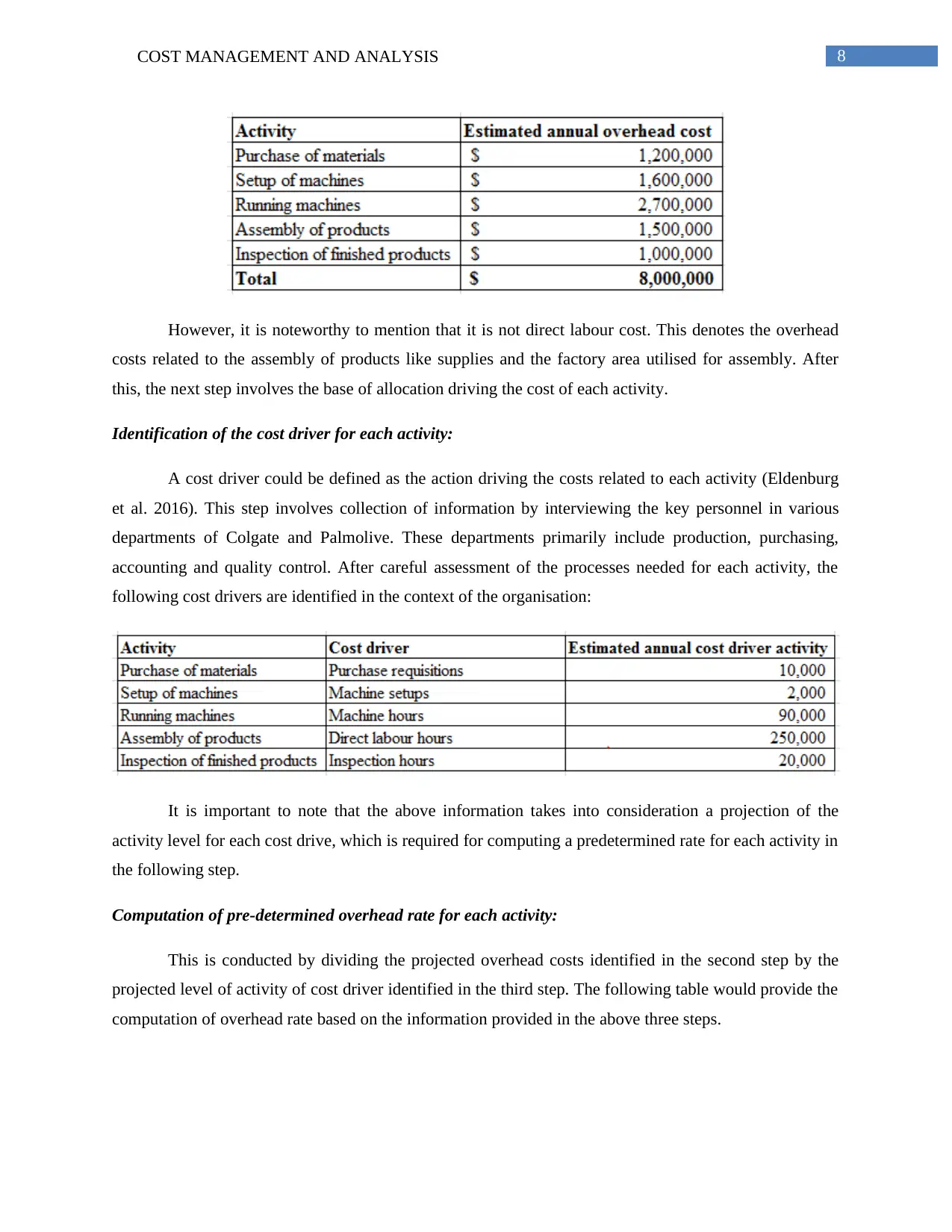
8COST MANAGEMENT AND ANALYSIS
However, it is noteworthy to mention that it is not direct labour cost. This denotes the overhead
costs related to the assembly of products like supplies and the factory area utilised for assembly. After
this, the next step involves the base of allocation driving the cost of each activity.
Identification of the cost driver for each activity:
A cost driver could be defined as the action driving the costs related to each activity (Eldenburg
et al. 2016). This step involves collection of information by interviewing the key personnel in various
departments of Colgate and Palmolive. These departments primarily include production, purchasing,
accounting and quality control. After careful assessment of the processes needed for each activity, the
following cost drivers are identified in the context of the organisation:
It is important to note that the above information takes into consideration a projection of the
activity level for each cost drive, which is required for computing a predetermined rate for each activity in
the following step.
Computation of pre-determined overhead rate for each activity:
This is conducted by dividing the projected overhead costs identified in the second step by the
projected level of activity of cost driver identified in the third step. The following table would provide the
computation of overhead rate based on the information provided in the above three steps.
However, it is noteworthy to mention that it is not direct labour cost. This denotes the overhead
costs related to the assembly of products like supplies and the factory area utilised for assembly. After
this, the next step involves the base of allocation driving the cost of each activity.
Identification of the cost driver for each activity:
A cost driver could be defined as the action driving the costs related to each activity (Eldenburg
et al. 2016). This step involves collection of information by interviewing the key personnel in various
departments of Colgate and Palmolive. These departments primarily include production, purchasing,
accounting and quality control. After careful assessment of the processes needed for each activity, the
following cost drivers are identified in the context of the organisation:
It is important to note that the above information takes into consideration a projection of the
activity level for each cost drive, which is required for computing a predetermined rate for each activity in
the following step.
Computation of pre-determined overhead rate for each activity:
This is conducted by dividing the projected overhead costs identified in the second step by the
projected level of activity of cost driver identified in the third step. The following table would provide the
computation of overhead rate based on the information provided in the above three steps.
⊘ This is a preview!⊘
Do you want full access?
Subscribe today to unlock all pages.

Trusted by 1+ million students worldwide
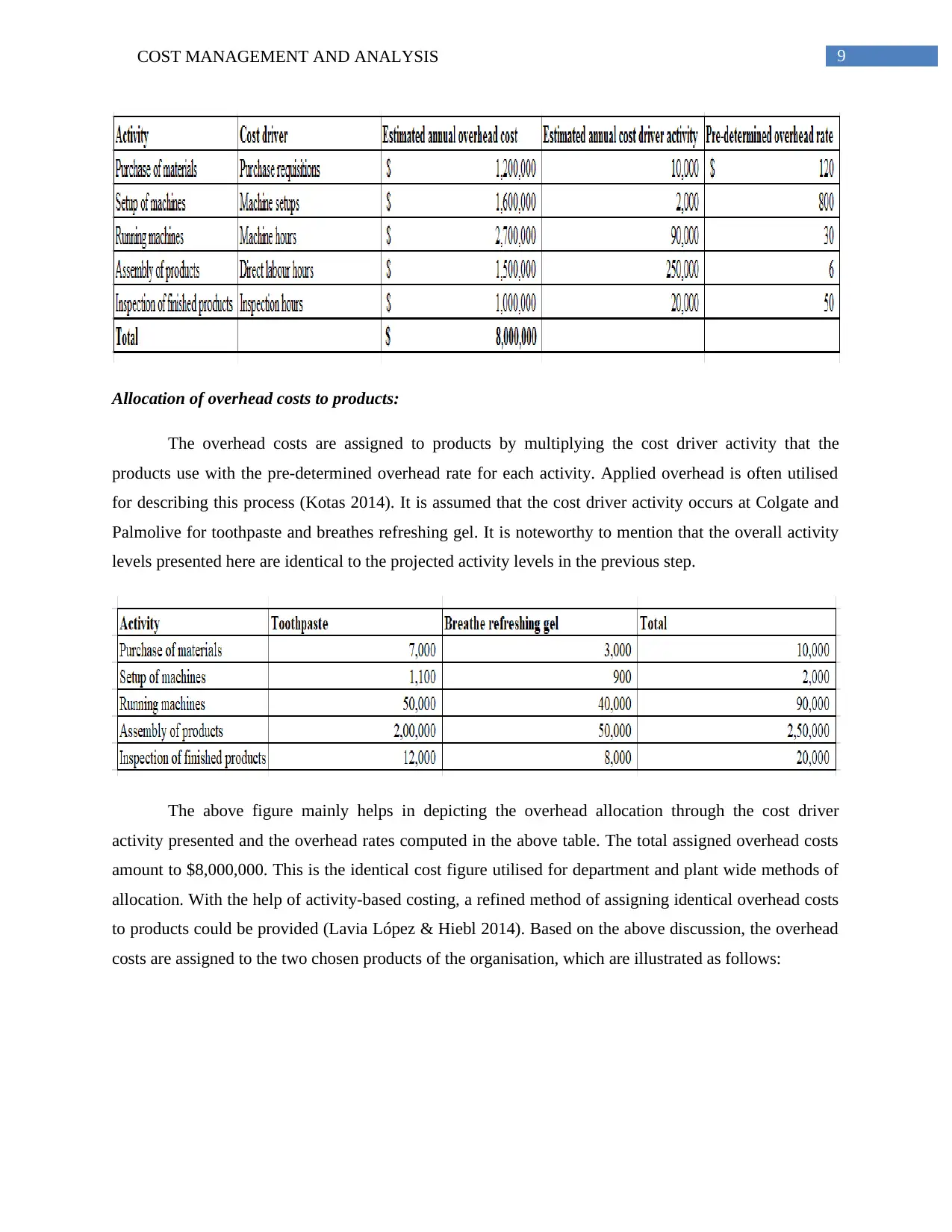
9COST MANAGEMENT AND ANALYSIS
Allocation of overhead costs to products:
The overhead costs are assigned to products by multiplying the cost driver activity that the
products use with the pre-determined overhead rate for each activity. Applied overhead is often utilised
for describing this process (Kotas 2014). It is assumed that the cost driver activity occurs at Colgate and
Palmolive for toothpaste and breathes refreshing gel. It is noteworthy to mention that the overall activity
levels presented here are identical to the projected activity levels in the previous step.
The above figure mainly helps in depicting the overhead allocation through the cost driver
activity presented and the overhead rates computed in the above table. The total assigned overhead costs
amount to $8,000,000. This is the identical cost figure utilised for department and plant wide methods of
allocation. With the help of activity-based costing, a refined method of assigning identical overhead costs
to products could be provided (Lavia López & Hiebl 2014). Based on the above discussion, the overhead
costs are assigned to the two chosen products of the organisation, which are illustrated as follows:
Allocation of overhead costs to products:
The overhead costs are assigned to products by multiplying the cost driver activity that the
products use with the pre-determined overhead rate for each activity. Applied overhead is often utilised
for describing this process (Kotas 2014). It is assumed that the cost driver activity occurs at Colgate and
Palmolive for toothpaste and breathes refreshing gel. It is noteworthy to mention that the overall activity
levels presented here are identical to the projected activity levels in the previous step.
The above figure mainly helps in depicting the overhead allocation through the cost driver
activity presented and the overhead rates computed in the above table. The total assigned overhead costs
amount to $8,000,000. This is the identical cost figure utilised for department and plant wide methods of
allocation. With the help of activity-based costing, a refined method of assigning identical overhead costs
to products could be provided (Lavia López & Hiebl 2014). Based on the above discussion, the overhead
costs are assigned to the two chosen products of the organisation, which are illustrated as follows:
Paraphrase This Document
Need a fresh take? Get an instant paraphrase of this document with our AI Paraphraser
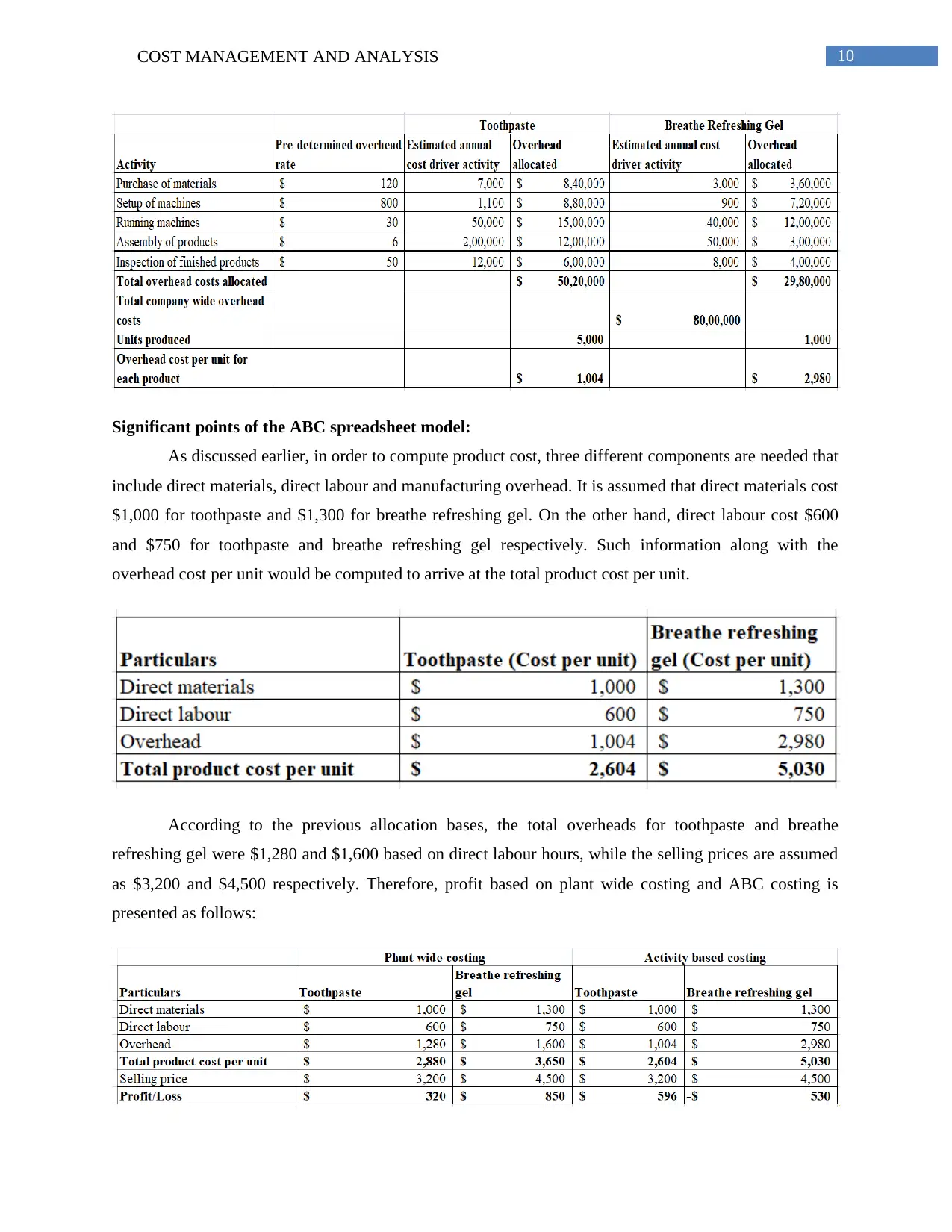
10COST MANAGEMENT AND ANALYSIS
Significant points of the ABC spreadsheet model:
As discussed earlier, in order to compute product cost, three different components are needed that
include direct materials, direct labour and manufacturing overhead. It is assumed that direct materials cost
$1,000 for toothpaste and $1,300 for breathe refreshing gel. On the other hand, direct labour cost $600
and $750 for toothpaste and breathe refreshing gel respectively. Such information along with the
overhead cost per unit would be computed to arrive at the total product cost per unit.
According to the previous allocation bases, the total overheads for toothpaste and breathe
refreshing gel were $1,280 and $1,600 based on direct labour hours, while the selling prices are assumed
as $3,200 and $4,500 respectively. Therefore, profit based on plant wide costing and ABC costing is
presented as follows:
Significant points of the ABC spreadsheet model:
As discussed earlier, in order to compute product cost, three different components are needed that
include direct materials, direct labour and manufacturing overhead. It is assumed that direct materials cost
$1,000 for toothpaste and $1,300 for breathe refreshing gel. On the other hand, direct labour cost $600
and $750 for toothpaste and breathe refreshing gel respectively. Such information along with the
overhead cost per unit would be computed to arrive at the total product cost per unit.
According to the previous allocation bases, the total overheads for toothpaste and breathe
refreshing gel were $1,280 and $1,600 based on direct labour hours, while the selling prices are assumed
as $3,200 and $4,500 respectively. Therefore, profit based on plant wide costing and ABC costing is
presented as follows:
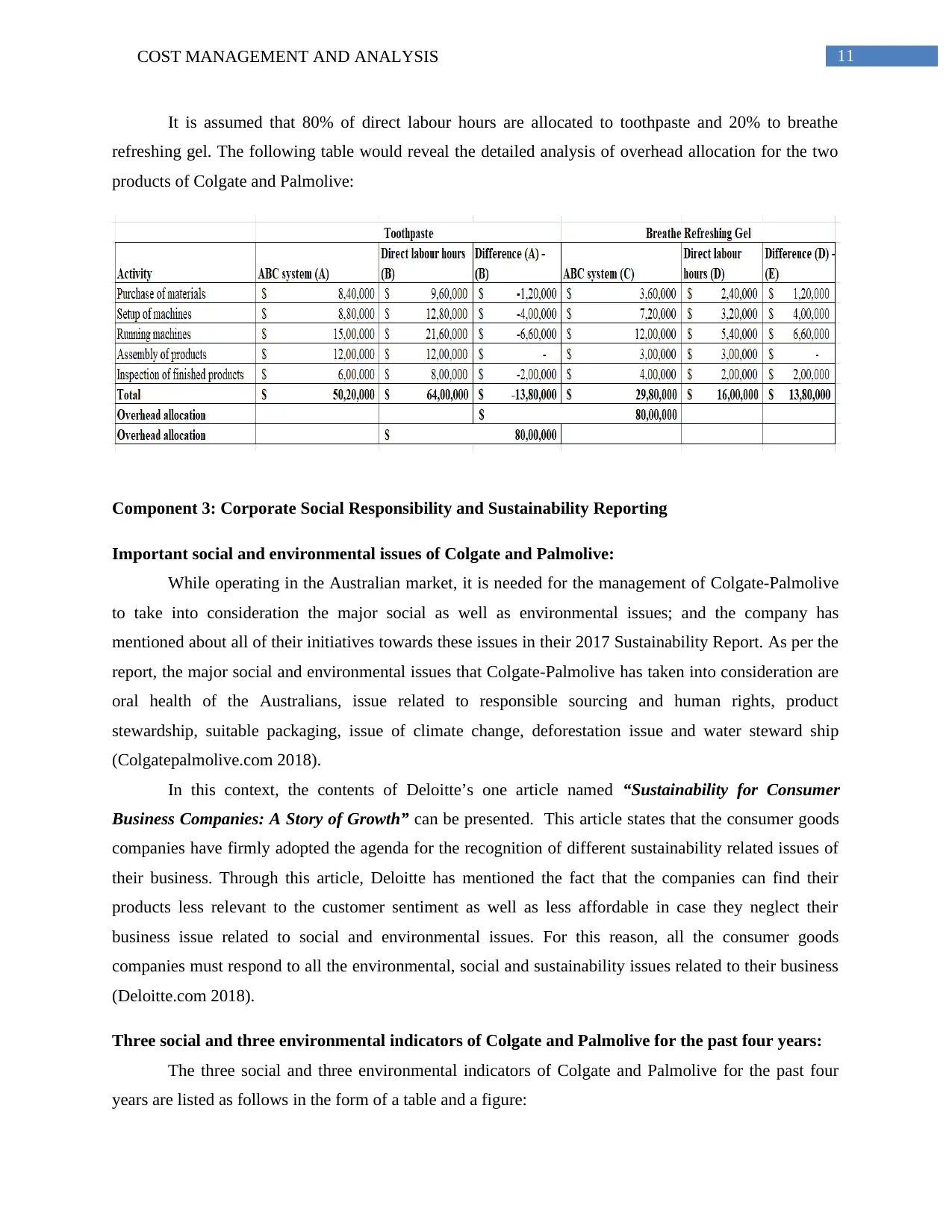
11COST MANAGEMENT AND ANALYSIS
It is assumed that 80% of direct labour hours are allocated to toothpaste and 20% to breathe
refreshing gel. The following table would reveal the detailed analysis of overhead allocation for the two
products of Colgate and Palmolive:
Component 3: Corporate Social Responsibility and Sustainability Reporting
Important social and environmental issues of Colgate and Palmolive:
While operating in the Australian market, it is needed for the management of Colgate-Palmolive
to take into consideration the major social as well as environmental issues; and the company has
mentioned about all of their initiatives towards these issues in their 2017 Sustainability Report. As per the
report, the major social and environmental issues that Colgate-Palmolive has taken into consideration are
oral health of the Australians, issue related to responsible sourcing and human rights, product
stewardship, suitable packaging, issue of climate change, deforestation issue and water steward ship
(Colgatepalmolive.com 2018).
In this context, the contents of Deloitte’s one article named “Sustainability for Consumer
Business Companies: A Story of Growth” can be presented. This article states that the consumer goods
companies have firmly adopted the agenda for the recognition of different sustainability related issues of
their business. Through this article, Deloitte has mentioned the fact that the companies can find their
products less relevant to the customer sentiment as well as less affordable in case they neglect their
business issue related to social and environmental issues. For this reason, all the consumer goods
companies must respond to all the environmental, social and sustainability issues related to their business
(Deloitte.com 2018).
Three social and three environmental indicators of Colgate and Palmolive for the past four years:
The three social and three environmental indicators of Colgate and Palmolive for the past four
years are listed as follows in the form of a table and a figure:
It is assumed that 80% of direct labour hours are allocated to toothpaste and 20% to breathe
refreshing gel. The following table would reveal the detailed analysis of overhead allocation for the two
products of Colgate and Palmolive:
Component 3: Corporate Social Responsibility and Sustainability Reporting
Important social and environmental issues of Colgate and Palmolive:
While operating in the Australian market, it is needed for the management of Colgate-Palmolive
to take into consideration the major social as well as environmental issues; and the company has
mentioned about all of their initiatives towards these issues in their 2017 Sustainability Report. As per the
report, the major social and environmental issues that Colgate-Palmolive has taken into consideration are
oral health of the Australians, issue related to responsible sourcing and human rights, product
stewardship, suitable packaging, issue of climate change, deforestation issue and water steward ship
(Colgatepalmolive.com 2018).
In this context, the contents of Deloitte’s one article named “Sustainability for Consumer
Business Companies: A Story of Growth” can be presented. This article states that the consumer goods
companies have firmly adopted the agenda for the recognition of different sustainability related issues of
their business. Through this article, Deloitte has mentioned the fact that the companies can find their
products less relevant to the customer sentiment as well as less affordable in case they neglect their
business issue related to social and environmental issues. For this reason, all the consumer goods
companies must respond to all the environmental, social and sustainability issues related to their business
(Deloitte.com 2018).
Three social and three environmental indicators of Colgate and Palmolive for the past four years:
The three social and three environmental indicators of Colgate and Palmolive for the past four
years are listed as follows in the form of a table and a figure:
⊘ This is a preview!⊘
Do you want full access?
Subscribe today to unlock all pages.

Trusted by 1+ million students worldwide
1 out of 17
Related Documents
Your All-in-One AI-Powered Toolkit for Academic Success.
+13062052269
info@desklib.com
Available 24*7 on WhatsApp / Email
![[object Object]](/_next/static/media/star-bottom.7253800d.svg)
Unlock your academic potential
Copyright © 2020–2025 A2Z Services. All Rights Reserved. Developed and managed by ZUCOL.





